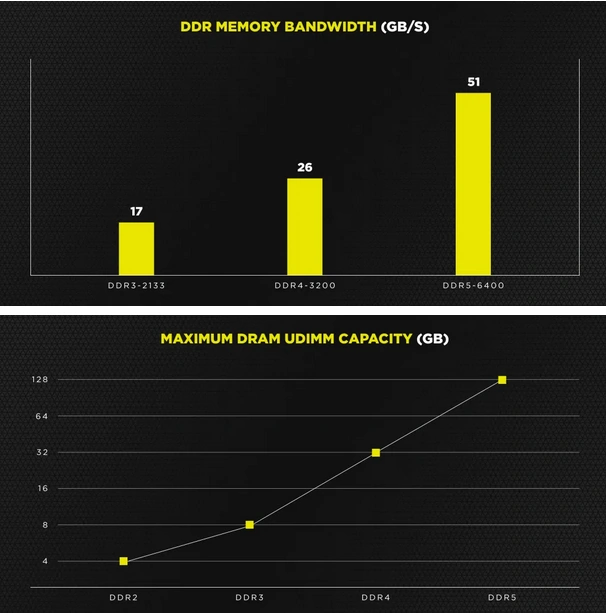Corsair DDR5-6400 promises 51GB/s of bandwidth
The memory module maker hints it will have DDR5-6400 memory modules later this year. No details about latency are revealed but the slides show the DDR5-6400 hits a memory bandwidth of 51GB/s. That's a lot higher than standard DDR4 memory -- but not very impressive versus today's enthusiast DDR4 memory.One of the benefits of DDR5 is that it allows a big boost in memory capacity. At least in theory, it will be possible to make memory modules with a capacity of 128GB. This allows you to mount 512GB with four modules, and enthusiast-class systems with eight memory slots could hit 1TB of memory in the future. Besides higher bandwidth and higher memory density, DDR5 also packs other enhancements such as lower operating voltage. It's also the first consumer memory to feature ECC.
Here's an overview from Corsair that outlines the advantages of DDR5:
With DDR5, individual modules are split into two separate channels by design, allowing for shorter traces that con-tribute to less latency and higher speeds when it comes to communicating with individual memory ICs on a memory module. This also allows for what’s referred to as command/address mirroring since the signal from the CPU has to travel a shorter overall path to access specific banks of memory whereas in DDR4 a command/address signal had to travel through all banks of memory in a longer chain.The first platform to support DDR5 will be Intel's Alder Lake-S. We don't know an exact launch date but it's expected that Alder Lake-S will be available towards the end of this year. At least for now, a lot of enthusiasts are hesitant about DDR5 over cost and latency concerns. Alder Lake-S supports both DDR4 and DDR5, so you will still be able to use cheaper DDR4 with Intel's new chip if you get a new motherboard with DDR4 support.
On DDR4, when a single bank of memory needed to be refreshed, the CPU had to wait for all banks of memory on a module to refresh before doing another read or write. With DDR5, we’ve got double the bank groups and when a bank needs to be refreshed only the same bank of each group is refreshed, allowing for the other memory bank groups to be accessed without the CPU having to wait.
Overall single access latency with DDR5 is relatively unchanged, while CAS Latency has increased, the overall latency of a top-tier DDR5 kit will be similar to previous generations of DRAM clocking in at 14-15ns thanks to the improvements we previously mentioned
ON-DIE ECC
Reliability goes down as process technologies shrink, resulting in higher latency and looser timings overall at higher speeds. DDR5 features on-die ECC as part of its spec, helping to reduce errors and allow for memory ICs to operate at higher frequencies. To be clear, this doesn’t mean that mainstream DDR5 is using a full-fledged ECC implementation, there’ll still be unregistered modules for typical consumer applications and ECC modules for enterprise/research applications.
MORE POWER TO THE MODULE
DDR5 memory ICs also require less power with Vdd dropping from 1.2v for DDR4 to 1.1v for DDR5, this isn’t exactly meaningful to most desktop users, but it does result in better overall power efficiency for portable devices such as gaming notebooks and smartphones (note that some flagship smart phones are shipping with over 12GB of LPDDR5 already).
Lower overall voltage requirements for DDR5 is only part of the picture, voltage regulation has been shifted from its current location on desktop motherboards to the individual modules by the inclusion of a power management integrated circuit (PMIC). This results in better overall voltage regulation for each module and improved DRAM IC yields which is great for overclocking and overall memory efficiency.
